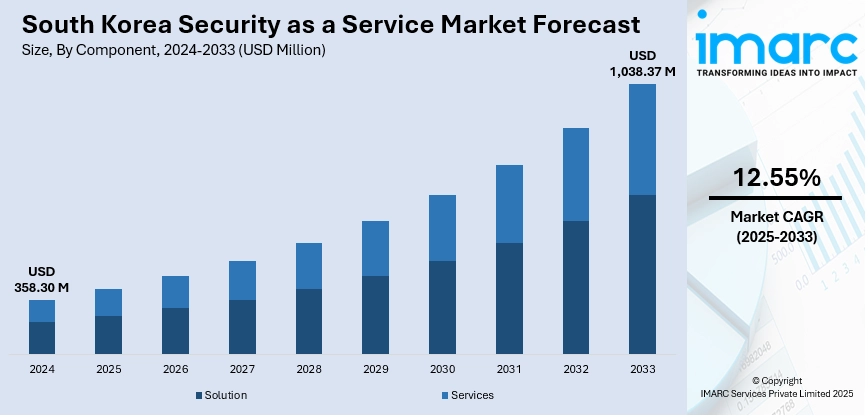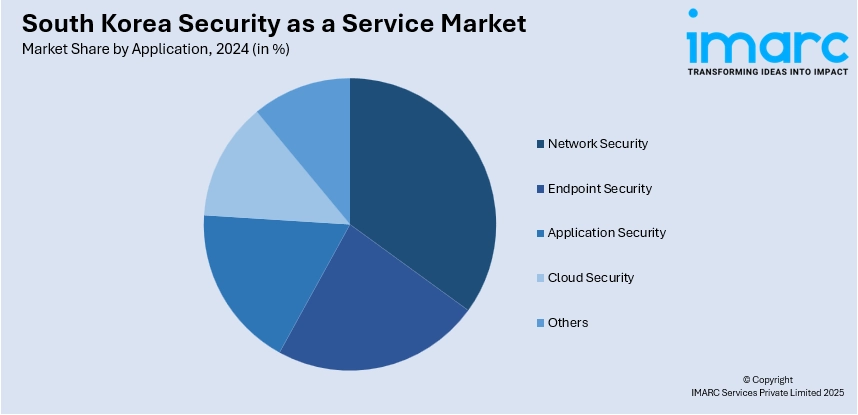
South Korea Security as a Service Market Size, Share, Trends and Forecast by Component, Organization Size, Application, Vertical, and Region, 2025-2033
South Korea Security as a Service Market Overview:
The South Korea security as a service market size reached USD 358.30 Million in 2024. Looking forward, IMARC Group expects the market to reach USD 1,038.37 Million by 2033, exhibiting a growth rate (CAGR) of 12.55% during 2025-2033. Rising cyber threats, rapid Internet of Things (IoT) device adoption, and a growing support for zero-trust security models are key factors driving the security as a service market in South Korea. These trends demand scalable, flexible, and cost-effective solutions that provide continuous monitoring, real-time threat detection, and enhanced access control across diverse, complex digital environments, which is contributing to an increase in the South Korea security as a service market share.
|
Report Attribute
|
Key Statistics
|
|---|---|
|
Base Year
|
2024
|
|
Forecast Years
|
2025-2033
|
|
Historical Years
|
2019-2024
|
| Market Size in 2024 | USD 358.30 Million |
| Market Forecast in 2033 | USD 1,038.37 Million |
| Market Growth Rate 2025-2033 | 12.55% |
South Korea Security as a Service Market Trends:
Rising Cybersecurity Threats and Digital Vulnerabilities
As the nation progresses in its digital economy and incorporates technologies like cloud computing, artificial intelligence (AI), and IoT, its infrastructure grows increasingly susceptible to cyber threats aimed at essential sectors such as finance, manufacturing, and government. Organizations are reacting by implementing scalable, strong security frameworks that can be rapidly deployed. Security as a service (SECaaS) offers ongoing updates, threat insights, and specialized oversight without significant initial expenses, rendering it an economical defense approach. For instance, the Korea Internet & Security Agency (KISA) indicated a 48% increase in cyber incidents in 2024, with occurrences rising from 1,277 to 1,887. This increase, along with local geopolitical conflicts, is raising awareness and prompted both public and private sectors to delegate cybersecurity tasks to specialized providers for more proactive and robust threat management.

To get more information on this market, Request Sample
Increased Use of IoT Devices
The swift expansion of IoT devices in South Korea is generating intricate security issues that conventional defenses cannot completely solve. In 2025, Arm introduced its Armv9 Edge AI platform in South Korea, showcasing cutting-edge processors designed for IoT security and efficiency. With the growing adoption of connected devices by industries and individuals, ranging from industrial sensors to smart home gadgets, the quantity of susceptible endpoints significantly increases. Numerous IoT devices have insufficient built-in security, rendering them attractive targets for cyberattacks. SECaaS provides a unified, flexible method to oversee, identify irregularities, categorize network data, and apply regulations across various devices instantaneously. This is vital in areas, such as manufacturing, healthcare, and smart cities, where the adoption of IoT is rapidly growing.
Support for Zero-Trust Security Frameworks
The increasing implementation of the zero-trust security model is a major factor influencing the South Korea security as a service market growth. With the rise of cloud usage and remote work, conventional perimeter defenses become less effective, so zero-trust’s principle of “never trust, always verify” becomes crucial. This model necessitates ongoing authentication, detailed access management, and immediate oversight, which are functions that contemporary SECaaS platforms deliver effectively. In 2025, Naru Security introduced ZeroTiCA, a subscription-driven Zero Trust service aimed at SMEs. This service utilizes AI-driven threat detection and immediate network surveillance to uncover internal threats such as lateral movement, facilitating preemptive defense. By enabling organizations to adopt zero-trust without costly infrastructure modifications, SECaaS solutions conform to changing regulatory requirements. With support from the government and industry for zero-trust implementation, SECaaS is becoming recognized as the effective, scalable method to update security and enhance resilience throughout South Korea.
South Korea Security as a Service Market Segmentation:
IMARC Group provides an analysis of the key trends in each segment of the market, along with forecasts at the country and regional levels for 2025-2033. Our report has categorized the market based on component, organization size, application, and vertical.
Component Insights:
- Solution
- Services
The report has provided a detailed breakup and analysis of the market based on the component. This includes solution and services.
Organization Size Insights:
- Small and Medium-sized Enterprises
- Large Enterprises
A detailed breakup and analysis of the market based on the organization size have also been provided in the report. This includes small and medium-sized enterprises and large enterprises.
Application Insights:

- Network Security
- Endpoint Security
- Application Security
- Cloud Security
- Others
The report has provided a detailed breakup and analysis of the market based on the application. This includes network security, endpoint security, application security, cloud security, and others.
Vertical Insights:
- BFSI
- Government and Defense
- Retail and E-Commerce
- Healthcare and Life Sciences
- IT and Telecom
- Energy and Utilities
- Manufacturing
- Others
A detailed breakup and analysis of the market based on the vertical have also been provided in the report. This includes BFSI, government and defense, retail and E-commerce, healthcare and life sciences, IT and telecom, energy and utilities, manufacturing, and others.
Regional Insights:
- Seoul Capital Area
- Yeongnam (Southeastern Region)
- Honam (Southwestern Region)
- Hoseo (Central Region)
- Others
The report has also provided a comprehensive analysis of all the major regional markets, which include Seoul Capital Area, Yeongnam (Southeastern Region), Honam (Southwestern Region), Hoseo (Central Region), and others.
Competitive Landscape:
The market research report has also provided a comprehensive analysis of the competitive landscape. Competitive analysis such as market structure, key player positioning, top winning strategies, competitive dashboard, and company evaluation quadrant has been covered in the report. Also, detailed profiles of all major companies have been provided.
South Korea Security as a Service Market Report Coverage:
| Report Features | Details |
|---|---|
| Base Year of the Analysis | 2024 |
| Historical Period | 2019-2024 |
| Forecast Period | 2025-2033 |
| Units | Million USD |
| Scope of the Report |
Exploration of Historical Trends and Market Outlook, Industry Catalysts and Challenges, Segment-Wise Historical and Future Market Assessment:
|
| Components Covered | Solution, Services |
| Organization Sizes Covered | Small and Medium-sized Enterprises, Large Enterprises |
| Applications Covered | Network Security, Endpoint Security, Application Security, Cloud Security, Others |
| Verticals Covered | BFSI, Government and Defense, Retail and E-Commerce, Healthcare and Life Sciences, IT and Telecom, Energy and Utilities, Manufacturing, Others |
| Regions Covered | Seoul Capital Area, Yeongnam (Southeastern Region), Honam (Southwestern Region), Hoseo (Central Region), Others |
| Customization Scope | 10% Free Customization |
| Post-Sale Analyst Support | 10-12 Weeks |
| Delivery Format | PDF and Excel through Email (We can also provide the editable version of the report in PPT/Word format on special request) |
Key Questions Answered in This Report:
- How has the South Korea security as a service market performed so far and how will it perform in the coming years?
- What is the breakup of the South Korea security as a service market on the basis of component?
- What is the breakup of the South Korea security as a service market on the basis of organization size?
- What is the breakup of the South Korea security as a service market on the basis of application?
- What is the breakup of the South Korea security as a service market on the basis of vertical?
- What is the breakup of the South Korea security as a service market on the basis of region?
- What are the various stages in the value chain of the South Korea security as a service market?
- What are the key driving factors and challenges in the South Korea security as a service market?
- What is the structure of the South Korea security as a service market and who are the key players?
- What is the degree of competition in the South Korea security as a service market?
Key Benefits for Stakeholders:
- IMARC’s industry report offers a comprehensive quantitative analysis of various market segments, historical and current market trends, market forecasts, and dynamics of the South Korea security as a service market from 2019-2033.
- The research report provides the latest information on the market drivers, challenges, and opportunities in the South Korea security as a service market.
- Porter's five forces analysis assist stakeholders in assessing the impact of new entrants, competitive rivalry, supplier power, buyer power, and the threat of substitution. It helps stakeholders to analyze the level of competition within the South Korea security as a service industry and its attractiveness.
- Competitive landscape allows stakeholders to understand their competitive environment and provides an insight into the current positions of key players in the market.
Need more help?
- Speak to our experienced analysts for insights on the current market scenarios.
- Include additional segments and countries to customize the report as per your requirement.
- Gain an unparalleled competitive advantage in your domain by understanding how to utilize the report and positively impacting your operations and revenue.
- For further assistance, please connect with our analysts.
 Request Customization
Request Customization
 Speak to an Analyst
Speak to an Analyst
 Request Brochure
Request Brochure
 Inquire Before Buying
Inquire Before Buying




.webp)




.webp)












